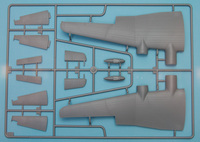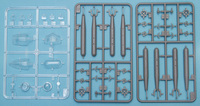Overview
 The Focke Wulf Fw 200 began life as a passenger aircraft, designed for the trans-Atlantic routes between Europe and North America. Its long wingspan and four engines made it a reliable performer in that role, and was the most modern airliner for a while until the arrival of the DC-4. The first Fw 200 took to the air in 1937, and the production version could carry 26 passengers over 1800 miles.
The Focke Wulf Fw 200 began life as a passenger aircraft, designed for the trans-Atlantic routes between Europe and North America. Its long wingspan and four engines made it a reliable performer in that role, and was the most modern airliner for a while until the arrival of the DC-4. The first Fw 200 took to the air in 1937, and the production version could carry 26 passengers over 1800 miles.
 The advent of war saw the modification of the Fw 200 into a patrol bomber. A strengthened fuselage, defensive armament, an under-fuselage gondola incorporating a bomb bay, and external hard points all added weight that decreased performance. Still, the Fw 200 was an excellent patrol aircraft, and it operated over the Atlantic in the maritime patrol and reconnaissance role, and on the Eastern Front as a transport aircraft.
The advent of war saw the modification of the Fw 200 into a patrol bomber. A strengthened fuselage, defensive armament, an under-fuselage gondola incorporating a bomb bay, and external hard points all added weight that decreased performance. Still, the Fw 200 was an excellent patrol aircraft, and it operated over the Atlantic in the maritime patrol and reconnaissance role, and on the Eastern Front as a transport aircraft.
The Kit
Given that Trumpeter has a nice 1/48 Fw 200 in their catalog, seeing this kit come out in 1/72 was no real surprise. Given that Revell has a very nice 1/72 Fw 200, though, one wonders if we really need another new-tool 1/72 Condor. This kit does have some advantages over the Revell kit, though, most notably a full interior. The kit is molded in the typical light gray plastic favored by Trumpeter, and features finely recessed panel lines throughout. The decal sheet comes with markings for two aircraft, one Luftwaffe and one Soviet.
 Starting with that full interior, be ready for quite a bit of assembly here. Starting at the front of the one-piece floor, the cockpit section has a separate instrument panel, control column, seats, and side consoles. The cockpit bulkhead is separate (as are all the bulkheads), and there are additional inserts for radios and whatnot for that piece. A key piece of the military Fw 200 version are the extra fuel tanks, and these are made up of three pieces each. The aft end of the cabin gets some more seats, a few other bits, and three more bulkheads. When the whole interior is finished, it will be quite crowded and will look every bit the part of an Fw 200 interior. Of course, buttoned up between the fuselage halves, little will be seen, but at least you know it's in there.
Starting with that full interior, be ready for quite a bit of assembly here. Starting at the front of the one-piece floor, the cockpit section has a separate instrument panel, control column, seats, and side consoles. The cockpit bulkhead is separate (as are all the bulkheads), and there are additional inserts for radios and whatnot for that piece. A key piece of the military Fw 200 version are the extra fuel tanks, and these are made up of three pieces each. The aft end of the cabin gets some more seats, a few other bits, and three more bulkheads. When the whole interior is finished, it will be quite crowded and will look every bit the part of an Fw 200 interior. Of course, buttoned up between the fuselage halves, little will be seen, but at least you know it's in there.
 With the fuselage together, the rest of the construction is very straightforward. The wing is made up from multiple pieces, starting from the one-piece lower center section. The lower outer panels mate up to this piece, and the one-piece right and left upper halves combine to keep everything aligned. The flaps and ailerons are separate, as are the rudder and elevators. The fabric detail on these is a bit overstated, and will need to be sanded down for a more realistic appearance.
With the fuselage together, the rest of the construction is very straightforward. The wing is made up from multiple pieces, starting from the one-piece lower center section. The lower outer panels mate up to this piece, and the one-piece right and left upper halves combine to keep everything aligned. The flaps and ailerons are separate, as are the rudder and elevators. The fabric detail on these is a bit overstated, and will need to be sanded down for a more realistic appearance.
 The engines are next, and these are pretty decent out of the box. The cowlings are split into halves, and trap the one-piece engine assembly inside. The exhausts are all separate, as is the ventral scoop. With some careful painting, these should be more than adequate. The landing gear is also quite good out of the box, with the main gear strut built up from nine pieces. Each wheel is split into halves, with a separate hub insert. The tailwheel strut is molded as one piece, incorporating the wheel.
The engines are next, and these are pretty decent out of the box. The cowlings are split into halves, and trap the one-piece engine assembly inside. The exhausts are all separate, as is the ventral scoop. With some careful painting, these should be more than adequate. The landing gear is also quite good out of the box, with the main gear strut built up from nine pieces. Each wheel is split into halves, with a separate hub insert. The tailwheel strut is molded as one piece, incorporating the wheel.
 The final bits in the assembly are the clear parts and the weaponry. The weaponry consists of three torpedoes, one under each wing and one under the central gondola. The clear parts include that gondola, as well as the usual canopy and side windows. For the parts that incorporate both clear and solid sections, the solid sections are frosted, which should help in masking.
The final bits in the assembly are the clear parts and the weaponry. The weaponry consists of three torpedoes, one under each wing and one under the central gondola. The clear parts include that gondola, as well as the usual canopy and side windows. For the parts that incorporate both clear and solid sections, the solid sections are frosted, which should help in masking.
 The color options are pretty much identical in terms of camouflage, consisting of RLM 70/71 over RLM 65. The Luftwaffe example has yellow wing undersides and a yellow fuselage band, while the Soviet option has a red fuselage band. Both have the globe emblem on the nose, a common sight on Fw 200s. Aside from that, the only other markings on the Soviet option are the red stars. The Luftwaffe option comes with code letters KE+IX. The decals are decent, and should present no problem in application.
The color options are pretty much identical in terms of camouflage, consisting of RLM 70/71 over RLM 65. The Luftwaffe example has yellow wing undersides and a yellow fuselage band, while the Soviet option has a red fuselage band. Both have the globe emblem on the nose, a common sight on Fw 200s. Aside from that, the only other markings on the Soviet option are the red stars. The Luftwaffe option comes with code letters KE+IX. The decals are decent, and should present no problem in application.
Conclusion
While this kit is quite a bit more than the Revell kit, it does come with more detail on the inside and also benefits from being in production right now. This kit looks to be quite fun to build, though, given that comprehensive interior, and as there is no shortage of Condor markings, there really is room for both. My thanks to Stevens International for the review sample.